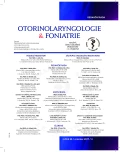Surgical Treatment of Septal Perforation - Own Experience
Authors:
M. Lásková; Marian Sičák
Authors‘ workplace:
Klinika ORL a chirurgie hlavy a krku ÚVN a FN, Ružomberok
Published in:
Otorinolaryngol Foniatr, 66, 2017, No. 4, pp. 192-197.
Category:
Original Article
Overview
Introduction:
Nasal septal perforation represents serious clinical problem. Etiologically, there are traumatic, iatrogenic and idiopathic perforations; perforations in granulomatous diseases are uncommon. Treatment is symptomatic or causal - surgery.
Objective:
The aim of our study was to evaluate the success of surgical treatment of nasal septal perforation using relaxing technique.
Material and methods:
The authors retrospectively analyzed patients with nasal septal perforation that were surgically treated at the Clinic of Otorhinolaryngology and Head and Neck Surgery at Military Faculty Hospital in Ruzomberok between 2004 - 2015. Etiology, size, localization of nasal perforation and success of surgical treatment were evaluated.
Results:
Fifty-seven patients underwent surgery for nasal septal perforation. The most common size of perforation was 10-20 mm. Perforations after septoplasty and idiopathic perforations occurred most frequently. All patients were treated surgically using relaxing technique. Thirty operations (52 %) were performed by open access. One year after surgery, the clinical success of surgery was 84 %. Open vs. the closed access did not affect the success of the operation. Negative effect on surgery had Nasal perforations greater than 20 mm, basal localization and perforations after previous septoplasty had negative effect on success of surgery.
Conclusion:
The success of surgical treatment of nasal septal depends on its size, location and etiology. Despite the precise surgical technique, it is not possible to achieve the success in all cases.
KEYWORDS:
nasal septal perforation, relaxing technique, success of treatment
Sources
1. Altun, H., Hanci, D.: Olfaction improvement after nasal septal perforation repair with the „cross – stealing“ technique. Am. J. Rhinol. Allergy, 29, 2015, 5, s. 142-145. Doi: 102500/ajtra.2015.29.4208.
2. Brain, U. J.: Septo-rhinoplasty: the closure of septal perforations. J. Laryngol. Tool. 94, 1980, s. 495-505.
3. Cassano, M.: Endoscopic repair of nasal septal perforation with „Slide and Patch“ Technigue. Otolaryngolo Head Neck Surg., 151, 2014, 1, s. 176-178. (Epub ahead of print.)
4. Doležal, P.: Rekonštrukcia perforácie nosovej priehradky. Otorinonolaryngológia a foniatria, Prague, 50, 2001, 1, s. 38-44.
5. Dosen, L. K., Haye, R.: Surgical closure of nasal septal perforation, early and long term observations. Rhinology, 49, 2011, 4, s. 486-491. Doi: 10.4193/Rhino10.236.
6. Ferreli, F., Khodaei, I., Palma, P.: Anterior ethmoidal artery septal flap for the management of septal perforation. Arch. Facial. Plast. Surg., 13, 2011, 6, s. 411-414. Doi:10.1001/archfacial. 2011.44. Epub 2011 Jun 20.
7. Gonzalez-Ulloa et al.: Aesthetic plastic surgery. Piccin Nuova Libraria S.p.A., Padova, 1988, 419 s. ISBN 0-8016-2778-8.
8. Kaya, E. et al.: Three layer interlocking: a novel technique for repairing a nasal septum perforation. Am. Ann. Otol. Rhinol. Laryngál., 124, 2015, 3, s. 212-21 5. Doi: 10.1177/0003489414550859. Epub 2014 Sept 14.
9. Kováč, M., Legiň, B.: Perforácie nosového septa - relaxing technika. Choroby hlavy a krku (Head and Neck Diseases) 1-2004.
10. La-Rosa, R., Medina, L., Galioto, P.: Le perforationi del setto nasale considerayioni chirurgiche. Acta Otolaryngol. Ital., 18, 1998, 4, s. 228-232.
11. Lee, D., Joseph, E. M., Pontelll, J., Turk, J. B.: Long-term results of dermal grafting for the repair of nasal septal perforations. Otolaryngol. Head Neck Surg., 120, 1999, 4, s. 483-486.
12. Lindemann, J. et al.: Intranasal temeratureand humidity profile in patient whith nasal septal perforation before and aftersurgicalclousere. Clin. Otolaryngol., 26, 2001, 5, s. 433-437.
13. Reichert, H. et al.: Intraoral flaps for reconstruction of the nose. Trans 6th Int Congr. Plast. Reconstr. Surg. Paris Mason, 1976.
14. Romo et al.: A graduated approach to the repair af nasal perforations. Plast. Reconstr. Surg., 103, 1999, 1, s. 66-75.
15. Schultz-Coulon, H. J.: Three-layer repair of nasoseptal defects. Otolaryngol. Head Neck Surg., 132, 2005, s. 213-218.
16. Schultz-Coulon, H. J.: Anmerkungen zur Septumplastik. HNO, 54, 2006, s. 59-69.
17. Sičák, M. a kolektiv: Rinológia choroby nosa a prínosových dutín. Prvé vydanie. Martin, Kozák – Press. 2006, 339 s. ISBN 80-969292-1-6.
18. Woolford, T. J., Jones, N. S.: Repair of nasal septal perforations using local flaps and a composite cartilage graft. J. Laryngolog. Otol., 115, 2001, 1., s. 22-25.
19. Virkkula, P., Môkitis, A. A., Vento, S. I.: Surgical outcome and complications of nasal septal perforation repair with temporal fascia and periosteal grafts. Clin. Med. Insights Ear Nose Thoat., 29, 2015, 8, s. 7-11. Doi: 10.4137/CMENT. S23230. Collection 2015.
20. Weller, P. et al.: Septumdefektverschluss: Ergebnisse der Bruckenlappentechnik nach Schultz-Coulon in offener Technik Laryngo-Rhino-Otol, 92, 2013, s. 732-736
21. Wong, S., Raghavan, U.: Outcome of surgical closure of nasal septal peforation. J. Laryngál. Otol., 124, 2010, 8, s. 868-874. Doi: 10.1017/S0022215110000745. Epub 2010 May 20.
Labels
Audiology Paediatric ENT ENT (Otorhinolaryngology)Article was published in
Otorhinolaryngology and Phoniatrics

2017 Issue 4
Most read in this issue
- Surgical Treatment of Septal Perforation - Own Experience
- Foreign Bodies in the Lower Respiratory Tract in Pediatric Patients
- Results of Surgical Treatment of Lagophthalmos in Facial Nerve Paralysis in ENT Department University Hospital in Košice – a Review of 50 Cases Lagophthalmos
- The Contribution of CT Navigation in Endoscopic Sinus Surgery: an Evaluation of Patient Postoperative Quality of Life and Olfaction Function Results
